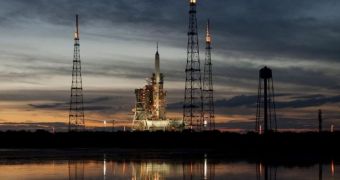Mission managers at the American space agency have just announced that they scrubbed the ARES I-X launch attempt that was scheduled for earlier today, on account of cloudy weather and powerful winds around the rocket. There were numerous attempts as the team tried to set the countdown clock rolling again, but there was little anyone could do to persuade Mother Nature. The built-in delay period, of 20 minutes, got longer and longer, until, at around 11.25 EDT (1525 GMT), mission controllers finally called off the attempts. Experts are currently discussing whether to try for a new launch tomorrow.
There were two main problems that the booster had to face, the soaring winds around Launch Pad 39B at the Kennedy Space Center (KSC), and the phenomenon known as “tribo electrification.” The maximum allowed level for the winds was of about 20 knots, but their actual speed increased constantly throughout the morning, until they finally exceeded the safety threshold, and climbed up to 22-23 knots.
Tribo electrification also forced the mission to be delayed. This phenomenon is very dangerous. It manifests itself when electrical charges build up on a climbing rocket, as it moves through the clouds. The discharges can cause severe damage to the delivery system's electronics, and can even break all communications between the spacecraft and the Mission Control.
A built-in hole of 20 minutes in the countdown began at T-4 minutes. “During this time, the launch team received weather verification, the Launch Authority Team got polled for a 'go' or 'no-go' for launch, and the launch test director conducted the final launch status verification,” a press release on NASA's website announces. The ARES I-X vehicle is made up of two stages. The first one has five segments, of which four are live, and the fifth is a dummy, while all of the upper part is just meant to replicate the actual weight that an ARES I upper stage would have in a real launch.
If the new prototype rocket had launched today, it would have marked the anniversary of the first Saturn 1 rocket launch, which took place on October 27, 1961, from Pad 34 at the Cape Canaveral Air Force Station. The flight plan itself was fairly simple. The rocket was to go supersonic within 30 seconds of the launch and then, about 124 seconds into the flight, finish the powered section of the test. Separation between the first stage and the dummy second stage would have taken place shortly after.
After the separation, the powered first stage should have begun its descent to the surface of the Atlantic Ocean. It was supposed to be guided to a designated location by three main chutes, which are triggered some 270 seconds after separation, the flight manifest adds. The stage was then to be recovered by the vessel Liberty that is charged with bringing it back to the KSC.

 14 DAY TRIAL //
14 DAY TRIAL //